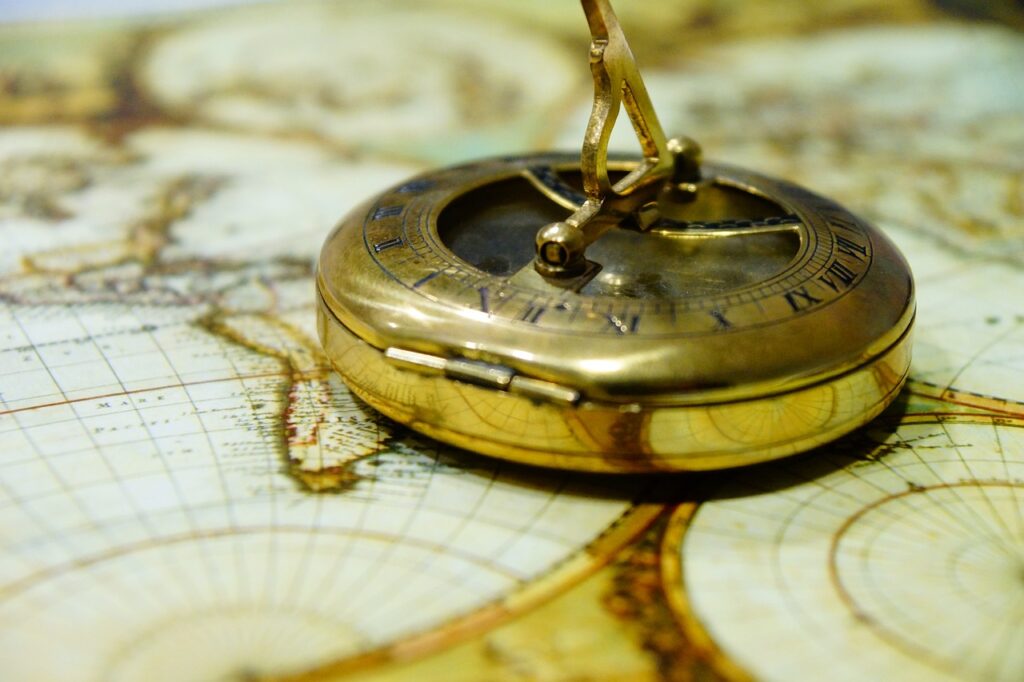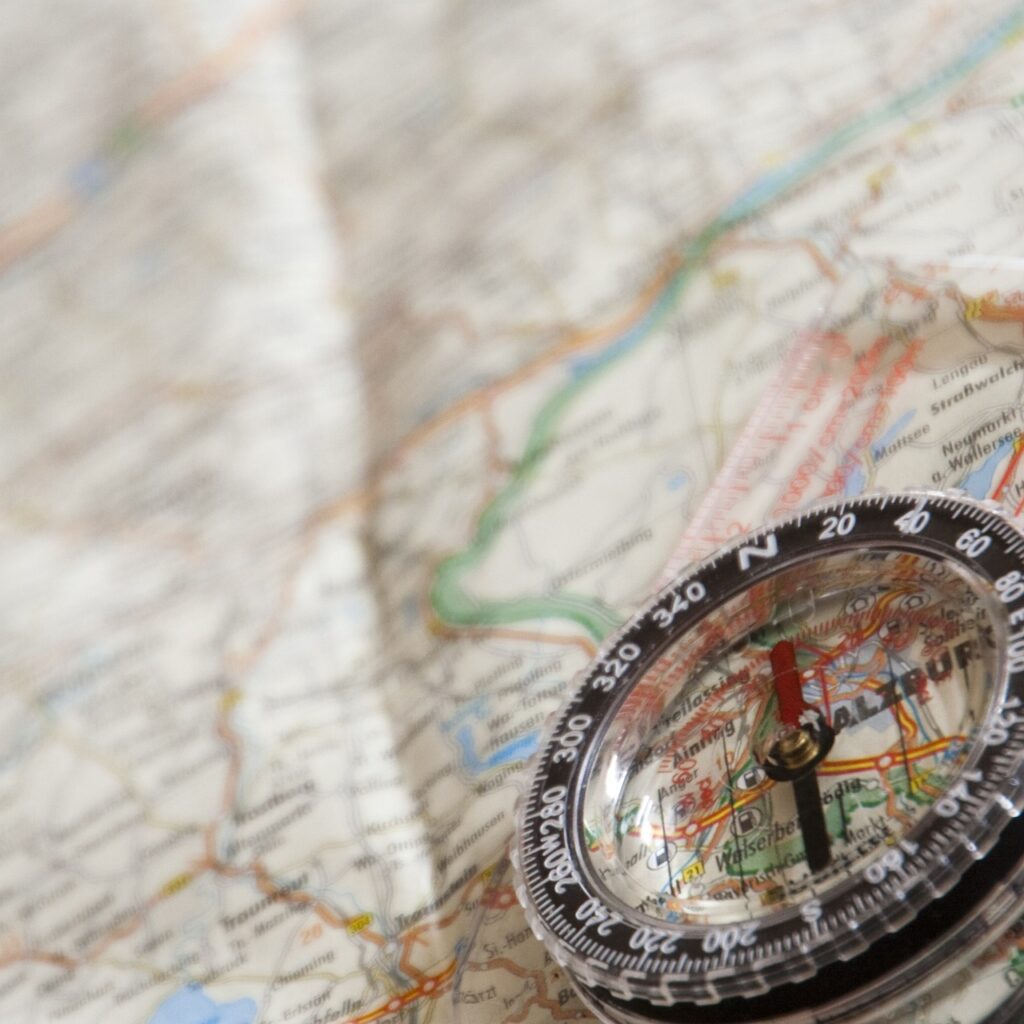How Do I Create A Basic Map And Compass Navigation Plan? Want to learn the skills of basic map and compass navigation? This article will guide you through the process of creating a simple yet effective navigation plan. By understanding the fundamentals of map reading and compass usage, you’ll gain the confidence to explore the great outdoors with ease and navigate your way to your desired destinations. So, grab your map and compass, and let’s get started on this exciting journey!
Understanding Map and Compass Navigation
What is map and compass navigation?
Map and compass navigation is the art of using a map and compass to determine your position and navigate from one point to another. It involves the understanding of various tools, techniques, and skills to read maps, interpret compass bearings, and follow routes accurately.
Why is map and compass navigation important?
Map and compass navigation is a crucial skill for outdoor enthusiasts, hikers, backpackers, and adventure seekers. While technology has advanced with GPS devices and smartphone apps, relying solely on technology can be risky in remote areas where satellite signals may be weak or nonexistent. With map and compass navigation skills, you become self-reliant and can confidently navigate through unfamiliar terrain, ensuring your safety and enhancing your overall outdoor experience.
Benefits of mastering map and compass navigation
Mastering map and compass navigation provides numerous benefits. Firstly, it gives you the freedom to explore off-the-beaten-path destinations and discover hidden gems that might not be included in typical guidebooks or digital maps. Secondly, it cultivates a sense of self-confidence and independence, allowing you to embark on outdoor adventures with reassurance. Additionally, map and compass navigation enhances your overall awareness of the surrounding landscape, helping you to spot interesting landmarks, wildlife, and natural features that you might have otherwise missed. Lastly, having proficient map and compass navigation skills can potentially save your life in emergency situations where technology may fail.
Acquiring the Right Tools
Choosing the right map
Choosing the right map is essential for effective map and compass navigation. Topographic maps, which display the shape and elevation of the terrain, are highly recommended. Ensure that the map covers the area you intend to explore, including the relevant trails, roads, and landmarks. It should also be durable and waterproof to withstand various weather conditions. Many regions have specialized maps available, such as those specifically designed for hiking or mountaineering, which provide additional useful information such as trail difficulty, camping spots, and water sources.
Selecting a suitable compass
A reliable compass is a fundamental tool for map and compass navigation. There are two main types of compasses: the baseplate compass and the lensatic compass. The baseplate compass is commonly used for basic navigation and is suitable for most outdoor activities. The lensatic compass, on the other hand, is more advanced and preferred by experienced navigators due to its precision and additional features. Whichever compass you choose, ensure it has a clear and easy-to-read dial, a rotating bezel for setting bearings, and a sighting mirror for accurate readings.
Other essential navigational tools
In addition to a map and compass, there are a few other essential tools that can aid your navigation. A protractor or map tool, also known as a romer, can help measure distances, angles, and bearings on the map. A pencil or pen is essential for marking your route or taking notes on the map. A personal GPS device can serve as a supplementary tool to cross-reference your map and compass readings. However, it’s important to remember that technology can fail, and it should not be relied upon solely for navigation. Lastly, a watch or timer is useful for keeping track of time and estimating travel duration.

Orientation and Map Reading
Orienting the map with a compass
Orienting the map means aligning it with the surrounding landscape, ensuring that the map corresponds to the actual terrain. To orient the map with a compass, place the compass on the map with the direction of travel arrow pointing towards the top of the map. Rotate the map and compass together until the magnetic needle on the compass is aligned with true north or magnetic north (taking magnetic declination into account). Once the map is properly oriented, you can confidently read and interpret the map’s features.
Identifying key landmarks
Identifying key landmarks on the map is crucial to determining your position and navigating accurately. Landmarks can include prominent peaks, ridgelines, rivers, lakes, or man-made structures. By comparing your surroundings with the landmarks depicted on the map, you can confirm your location and make informed navigational decisions. It’s important to familiarize yourself with the symbols and markings used on the map to correctly interpret the features and their significance.
Understanding map symbols and markings
Map symbols and markings provide valuable information about the terrain, such as vegetation, water sources, man-made structures, and contour lines. Contour lines, in particular, represent the shape and elevation of the land. Understanding how to interpret contour lines allows you to visualize the terrain, identify steep slopes, valleys, and ridges. By combining this information with your physical surroundings, you can gain a better understanding of the landscape and plan your route accordingly.
Reading contour lines and elevation
Reading contour lines is a vital skill for navigating in varying elevations. Contour lines are represented as curved lines on the map, connecting points of equal elevation. Contour intervals indicate the vertical distances between contour lines. Closely spaced contour lines indicate steep slopes, while widely spaced contour lines represent gentle slopes or flat areas. By assessing contour lines, you can visualize the terrain’s steepness and anticipate potential challenges, as well as choose suitable routes based on your abilities and preferences.
Determining Distance and Time
Using the map scale
The map scale is a crucial factor in determining distances on the map. It represents the relationship between the distance on the map and the actual distance on the ground. By using a ruler or the edge of the compass, measure the distance between two points on the map and convert it to the actual distance using the map scale. This allows you to estimate the length of your route, plan for rest stops, and calculate travel time.
Calculating distance using pacing
Pacing is a simple and practical method to estimate distances while on the move. By determining your average pace length, you can count your steps and calculate distances traveled. Start by measuring a known distance (e.g., 100 meters) and count the number of steps you take. Divide the known distance by the number of steps to obtain your pace length. Once you have your pace length, count your steps while traveling between known points on the map to estimate the distance covered.
Estimating travel time
Estimating travel time is crucial for planning your journey and ensuring you reach your destination within the desired timeframe. By considering the distance to be covered, the terrain, your physical condition, and any potential obstacles, you can approximate your travel time. Allow extra time for breaks, rest stops, and unforeseen circumstances. It’s important to remember that travel times can vary depending on personal factors, weather conditions, and the difficulty of the terrain.

Navigating with Compass Bearings
Understanding compass bearings
Compass bearings are angular measurements that indicate a direction relative to magnetic north or true north. They are expressed in degrees, with 360 degrees representing a full circle. In map and compass navigation, bearings are used to determine the direction of travel to reach a specific destination or follow a desired route. By understanding how to interpret compass bearings, you can confidently navigate using your compass and stay on track.
Taking accurate bearings
Taking accurate bearings is key to precise navigation. To take a bearing, align the direction of travel arrow on your compass with your current location and the desired landmark or target on the map. Make sure the compass housing is parallel to the map, and rotate the bezel until the orienting lines align with the magnetic needle. Read the bearing indicated by the index line on the compass housing. This bearing represents the direction you need to follow to reach your destination.
Using a bearing to navigate
Using a bearing to navigate involves aligning the compass with the desired direction and maintaining that bearing while traveling. To follow a bearing, hold your compass in front of you with the direction of travel arrow pointing straight ahead. Rotate your body until the magnetic needle aligns with the orienting arrow inside the compass housing. Look up from the compass and choose a point in the distance that aligns with your bearing. Walk towards that point, periodically checking your compass to ensure you stay on track.
Following a Route
Planning a route
Planning a route is crucial to an enjoyable and successful journey. Start by identifying your starting point and destination on the map. Refer to key landmarks, trails, and features to create a route that suits your preferences and abilities. Take into account terrain difficulty, water and food availability, and any potential hazards. Consider alternative routes and escape routes in case of emergencies. Mark your route on the map, ensuring it aligns with your chosen checkpoints and waypoints.
Using checkpoints and waymarks
Checkpoints and waymarks serve as reference points along your route. Checkpoints are key locations you plan to pass near or visit, such as junctions, mountain peaks, or river crossings. Mark these points on your map and be sure to identify them clearly in the field. Waymarks, on the other hand, are visual or physical features that provide reassurance and help confirm that you are on the right path, such as distinctive trees, boulders, or trail markers. Use both checkpoints and waymarks to navigate accurately and track your progress.
Staying on track
Staying on track requires constant vigilance and attentiveness to your surroundings. Regularly refer to your map, orient it to match the terrain, and compare it to your physical surroundings. Keep an eye out for key landmarks, intersections, and trail signs that align with your planned route. Check your compass frequently to ensure you are maintaining the correct bearing. If you become uncertain of your location, backtrack to a known point or use additional techniques such as triangulation to confirm your position.

Adjusting for Magnetic Declination
What is magnetic declination?
Magnetic declination is the angular difference between magnetic north, as indicated by your compass, and true north, the direction towards the North Pole. This variance occurs due to differences in the Earth’s magnetic field and can vary depending on your location. Failing to account for magnetic declination can lead to navigational errors and misinterpretations of direction. It is important to adjust your compass readings to accommodate the magnetic declination specific to your area.
How to determine and adjust for magnetic declination
To determine the magnetic declination in your area, consult a topographic map or reliable online resources specific to your region. The declination information is typically provided on the map or can be found through local geological or governmental organizations. Once you have this information, you can adjust your compass readings accordingly. Many compasses have a built-in adjustable declination scale, allowing you to set the correct declination for your location. By adjusting for magnetic declination, you ensure accurate navigation and prevent potential navigational errors.
Using Triangulation for Position Finding
Understanding triangulation
Triangulation is a method used to determine your precise position by drawing imaginary lines between three or more landmarks. By measuring the angles between these lines, you can pinpoint your location on the map where these lines intersect. Triangulation is particularly useful when you are uncertain of your exact position or when landmarks are clearly visible and identifiable.
Choosing suitable landmarks
When applying triangulation, it is crucial to select suitable landmarks that are visible both on the map and in the field. Ideally, these landmarks should be distinct, easily identifiable, and widely spaced. Mountain peaks, distinctive rock formations, towers, or large buildings often serve as excellent landmarks for triangulation. Ensure that the chosen landmarks are visible from your current location and that you can accurately measure the angles between them.
Triangulating your position
To triangulate your position, start by identifying three suitable landmarks visible from your location. Place your compass on the map, aligning one edge of the compass with one landmark. Rotate the compass until the other edge aligns with the second landmark, creating a line on the map. Repeat this process with the third landmark. The intersection of the lines drawn on the map represents your estimated position. It’s important to note that the more landmarks you use, the more accurate your triangulated position will be.
Navigating in Challenging Terrain or Conditions
Navigating in dense forests
Navigating in dense forests presents unique challenges due to limited visibility and obstructed landmarks. In such conditions, careful map reading and maintaining a constant bearing become crucial. Focus on identifying distinct features such as clearings, streams, or rock formations that can act as temporary checkpoints. Use your compass to maintain a consistent direction of travel and periodically update your location on the map by estimating distances traveled.
Navigation techniques for open fields
Open fields, devoid of prominent landmarks, can be challenging to navigate. In these situations, using pacing and compass bearings become essential. Establish a clear landmark as a reference point, such as a distant tree, and navigate towards it by taking accurate compass bearings. Use pacing to estimate distances between open field features or landmarks. Frequent map checks are important to ensure you stay on track and maintain your desired direction.
Navigating in poor visibility or at night
Navigating in poor visibility or at night requires additional caution and reliance on your navigational tools. Use a headlamp or flashlight to continuously illuminate your compass and map, allowing you to maintain a clear view. Be cautious of visual distortions caused by limited visibility and adjust your pace and navigation accordingly. It is crucial to slow down, focus on your compass bearings, and use additional techniques like pacing and dead reckoning to maintain your direction and estimate distances traveled.
Ongoing Navigation Skills Development
Practicing navigation in varying environments
To continually enhance your map and compass navigation skills, make a point to practice in varying environments. Choose different types of terrains, from forests to mountains to coastal regions, and challenge yourself with navigation exercises. Experiment with different tools and techniques, and push your boundaries by venturing into unfamiliar areas. Each practice session will increase your confidence and strengthen your navigational abilities, allowing you to tackle more challenging adventures.
Participating in orienteering or navigation courses
Participating in orienteering or navigation courses can greatly improve your skills and provide valuable hands-on experience. These courses often involve practical exercises, map reading challenges, and navigational competitions, allowing you to learn from instructors and interact with fellow navigators. The guidance and feedback from experienced navigators can help you refine your techniques, introduce new strategies, and expose you to advanced navigation concepts.
Seeking guidance from experienced navigators
Seeking guidance from experienced navigators can provide invaluable insights and tips for enhancing your map and compass navigation skills. Connect with local hiking clubs, outdoor organizations, or online communities to find mentors or fellow navigation enthusiasts who can share their expertise. Engaging in conversations, attending workshops, or participating in group hikes will expose you to different perspectives and enable you to learn from the experiences of seasoned navigators.
By understanding the fundamentals of map and compass navigation, acquiring the right tools, and honing your skills through practice and ongoing learning, you can confidently navigate through diverse landscapes and enjoy memorable outdoor adventures. With each exploration, you will deepen your appreciation for the natural world and develop a profound sense of self-reliance, making map and compass navigation an essential and rewarding skill for any outdoor enthusiast.
